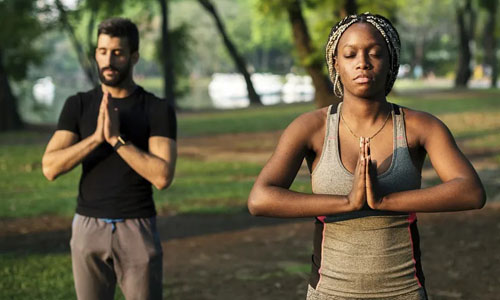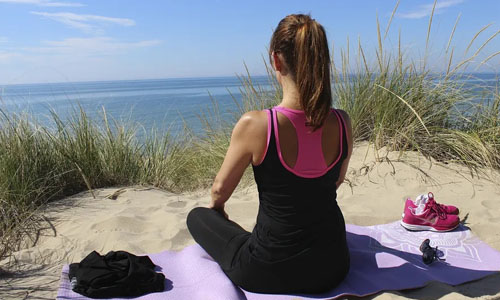Breathing Exercises: The Why and How of Healthy Living
We all have faced the feeling, the rapid breathing, and the shallow constriction that makes us reach out for more air as we speed our legs, hoping to pull more air in to reach the destination faster. But, the more we try, the shallower the chest heaves, and the struggle becomes harder.

Breathing exercises don't take away the gasping. What they do is help you endure more and breathe better as you speed up. Most runners and sportspersons practice breathing exercises to strengthen their lungs.
Why are Breathing Exercises Beneficial?
For a healthy lung, breathing in and out is easy. As you exhale and inhale, your lungs filter the air and send out the waste gases. But when you suffer from a condition like asthma and COPD, the lungs lose their natural ability to filter which results in the entrapment of air inside, causing difficulties in breathing. As this carries on, the excess air starts building up which leaves very less room for diaphragm contractions. And, when the diaphragm does not work to its full extent, the body starts to use other muscles present in the chest, neck, and even back for breathing. Thus, the body faces lower oxygen levels. Breathing exercises can help get rid of the stale air accumulated inside and allow the diaphragm to work at its full capacity.
Breathing Exercise While Sitting
Begin by breathing through your nose instead of your mouth. This helps stimulate the parasympathetic nervous system (PNS). Relax and let your lungs inflate to full capacity.
*Why shouldn't you breathe from your mouth? Because breathing from the mouth turns on the fight-or-flight response and the adrenals, the upper lobes present in the lungs are automatically restricted.*
Exercise by trying diaphragm pushups. Lay flat on the back. Add some weight to your chest. Inhale and exhale through your nose. Inhale and wait for 2 seconds before exhaling. Increasing the time count as you carry on. Continue doing this even while trying other exercises. This will not only strengthen your lungs but also help in assimilating oxygen. Keep repeating this to ensure that you get better at holding your breath.
*However, don't hold your breath if you have high blood pressure, brain injury, glaucoma, or any recent surgery done in the abdomen.*.
Another important aspect of breathing exercise is to free the space taken by a tight rib cage. Through these exercises, you can free some space by stretching the intercostal muscles. Inhale, wait for a few seconds and then inhale again without exhaling. Repeat through your exercise regime or in multiple intervals throughout the day.

Breathing Exercise While Running
One way of increasing your endurance is by strengthening your lungs. You can make this happen by following rhythmic patterns. Learn how to breathe in air through your diaphragm. That means you will have to inhale through your belly. The contraction caused in doing so will help your rib cage expand and provide a larger volume in the chest to draw the air into the lungs.
The key to any breathing exercise is to allow your diaphragm to work to its full potential. Inhaling more air means providing more oxygen to your circulatory system which will allow your muscles to work better.
Categories
- Sport (28)
- Product Reviews (3)
- Team Outdoor Look (7)
- Mike Wild (2)
- Mike Payton (2)
- Suse Hammond-Pears (3)
- Snowboarding (12)
- Latest Offers (105)
- Shop Talk (1)
- Competitions (7)
- Walking (413)
- Lifestyle Fashion (8)
- Travel (86)
- Kit Guides (176)
- Workwear Clothing (6)
- Safety Workwear (4)
- Health/Fitness (289)
- Skiing (91)
- Great Outdoors (1316)
- Cycling (92)
- January 2025
- December 2024
- November 2024
- October 2024
- September 2024
- August 2024
- July 2024
- June 2024
- May 2024
- April 2024
- March 2024
- February 2024
- January 2024
- December 2023
- November 2023
- October 2023
- September 2023
- August 2023
- July 2023
- June 2023
- May 2023
- April 2023
- March 2023
- February 2023
- January 2023
- December 2022
- November 2022
- October 2022
- September 2022
- August 2022
- July 2022
- June 2022
- May 2022
- April 2022
- March 2022
- February 2022
- January 2022
- December 2021
- November 2021
- October 2021
- September 2021
- August 2021
- July 2021
- June 2021
- May 2021
- April 2021
- March 2021
- February 2021
- January 2021
- December 2020
- November 2020
- October 2020
- September 2020
- August 2020
- July 2020
- June 2020
- May 2020
- April 2020
- March 2020
- February 2020
- January 2020
- December 2019
- November 2019
- October 2019
- September 2019
- August 2019
- July 2019
- June 2019
- May 2019
- April 2019
- March 2019
- February 2019
- January 2019
- December 2018
- November 2018
- October 2018
- September 2018
- August 2018
- July 2018
- June 2018
- May 2018
- April 2018
- March 2018
- February 2018
- January 2018
- December 2017
- November 2017
- October 2017
- September 2017
- August 2017
- July 2017
- June 2017
- May 2017
- April 2017
- March 2017
- February 2017
- January 2017
- December 2016
- November 2016
- October 2016
- September 2016
- August 2016
- July 2016
- June 2016
- May 2016
- April 2016
- March 2016
- February 2016
- January 2016
- December 2015
- November 2015
- October 2015
- September 2015
- August 2015
- July 2015
- June 2015
- May 2015
- April 2015
- March 2015
- February 2015
- January 2015
- December 2014
- November 2014
- October 2014
- September 2014
- August 2014
- July 2014
- June 2014
- May 2014
- April 2014
- March 2014
- February 2014
- January 2014
- December 2013
- November 2013
- October 2013
- September 2013
- August 2013
- July 2013
- June 2013
- May 2013
- April 2013
- March 2013
- February 2013
- January 2013
- December 2012
- November 2012
- October 2012
- September 2012
- August 2012
- July 2012
- June 2012
- May 2012
- April 2012
- March 2012
- February 2012
- January 2012
- December 2011
- November 2011
- October 2011
- September 2011
- August 2011
- May 2010
- April 2010
- March 2010
- February 2010
- January 2010
- November 2009
- October 2009
- September 2009


Submit a Comment